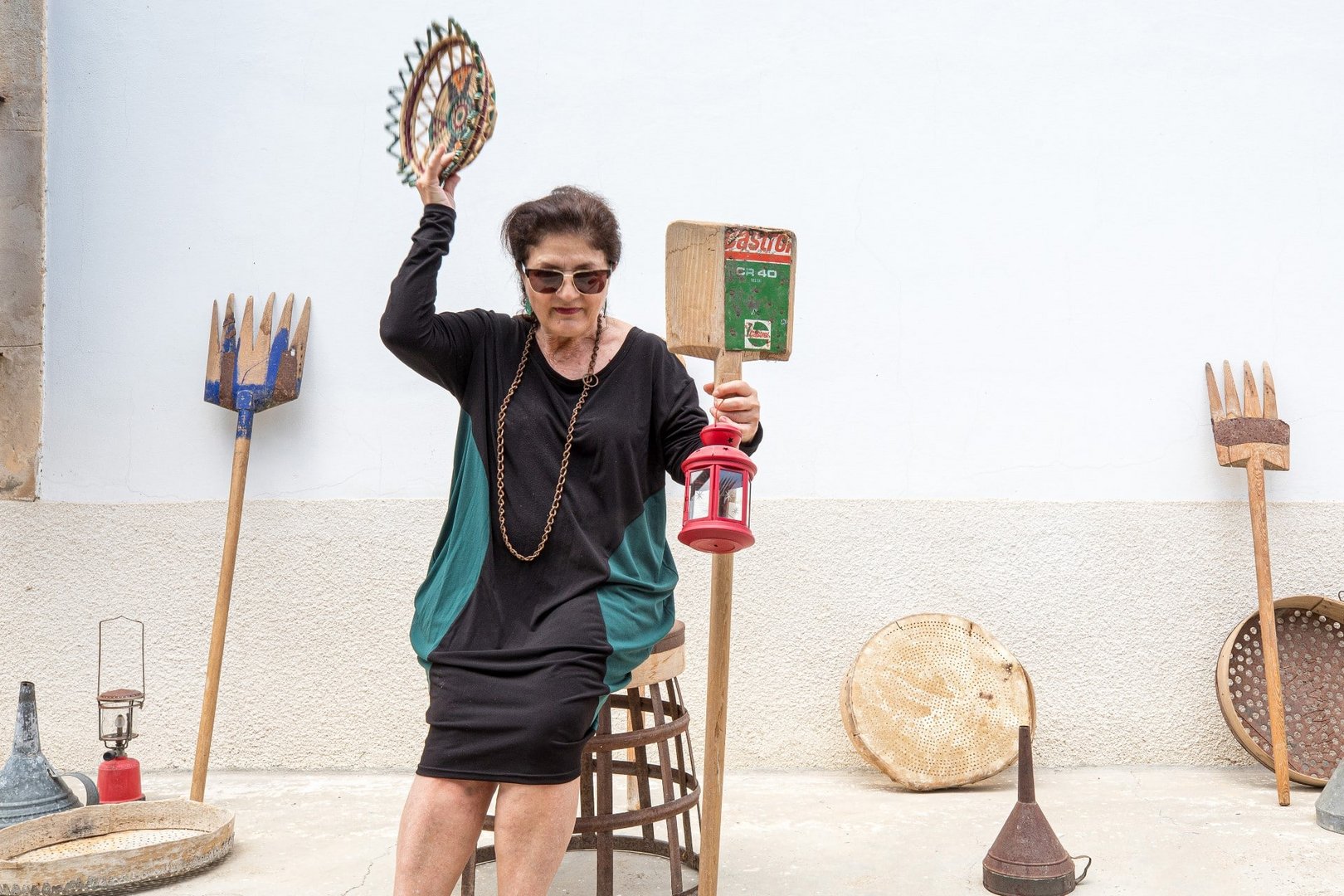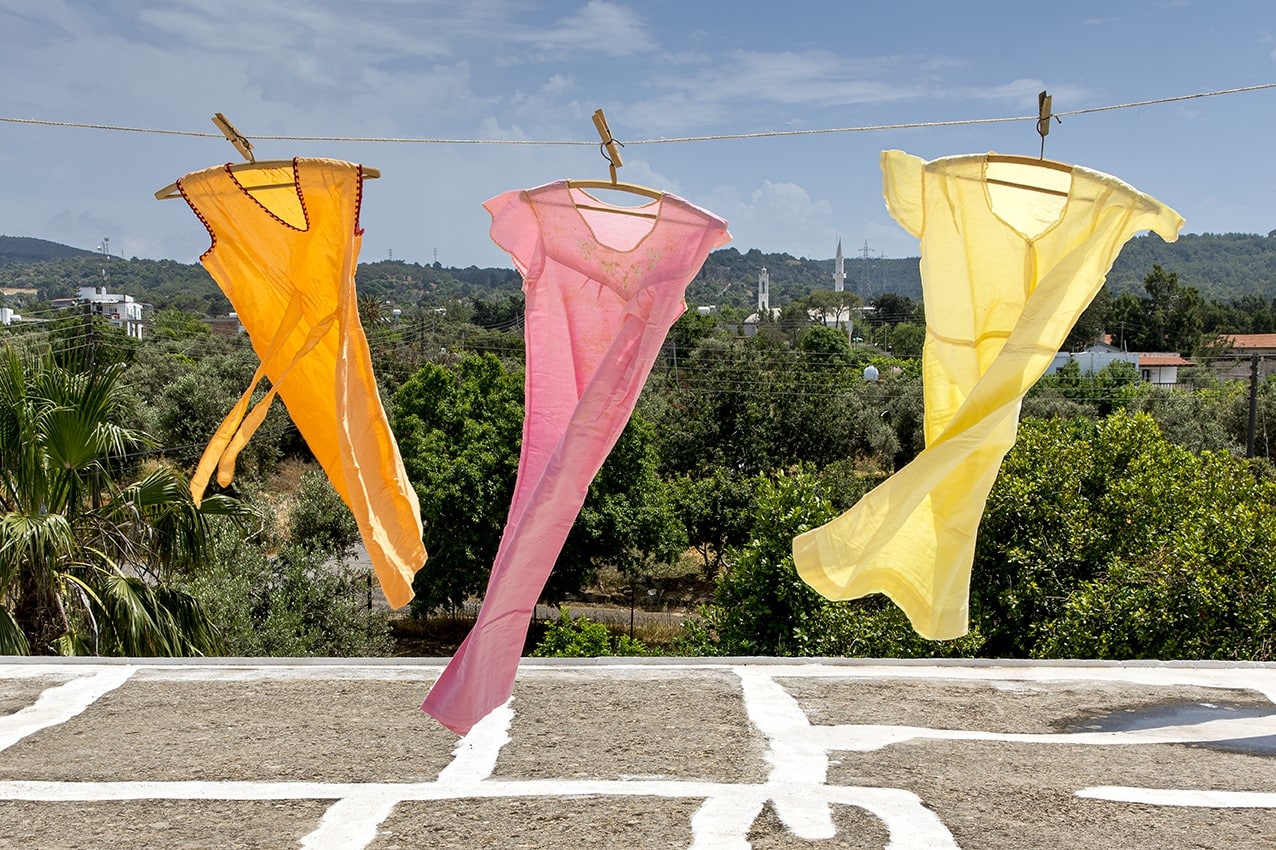A new exhibition marks 50 years since the Turkish invasion with very personal memories of a Karpasia artist
A new exhibition marks 50 years since the Turkish invasion with very personal memories of a Karpasia artist
Toula Liasi’s personal story is testament to the lives of those few hundred Greek Cypriots who insisted on remaining in their homes in northern Cyprus following the division of the island in 1974.
The objects that make up the works in her Larnaca exhibition entitled ‘Synchronising History’ which was inaugurated on Friday evening have 88 years of history. They tell the story of her family and the life she endured after the Turkish invasion divided the island, as well as the calamities of her family and those of many others who decided to stay behind in the village of Ayia Triada in Karpasia and live as enclaved.
“For the last two decades, my artwork has dealt with the difficult aspects of the recent history of Cyprus,” says Liasi on the occasion of her exhibition, a rare event considering Liasi now calls The Netherlands her home.
Her main source of inspiration comes from very personal experiences relating to the issues of the Missing – her brother was listed as missing for 40 years – and the enclaved in Karpasia.
At the tender age of 17, Liasi found herself trapped in Karpasia after the invasion. “The decision to stay behind did not come to us immediately,” recalls Toula, “it was made according to the circumstances and with time, it was not possible for us to leave anymore,” she adds.
At the time, a political agreement was reached to allow Greek Cypriot high school graduates to finish their last year of high school in a gymnasium in the south of the island. By 1975 Liasi was able to leave the peninsula to finish her education, an opportunity that ultimately meant that she would leave her parents. She studied art in Athens, then in the Hague and Rotterdam.
But the enclaved in Karpasia remained her artistic inspiration.
“My aim is to create an artistic monument in which personal and collective memories will not only coexist, but will also be transformed into independent evidence of the Cypriot reality,” she explained. “An artistic monument where painful and agonising issues of the past placed in the present bring us face to face with forgotten circumstances which tend to be lost in the oblivion of time. Situations that I do not want to go unnoticed, such as that of the enclaved in Karpasia; of this small group of people who, for decades, were left to fade in time and space.”
Today, the Larnaca Municipal Art Gallery hosts over 55 of Liasi’s multimedia artworks (paintings, photographs, videos and installations) that focus on her paternal home and its objects. These objects are silent witnesses and tell the story of the people of Karpasia without words, and in turn, personal experiences and objects become part of the collective memory of the place.
“My paternal home played an exceptional and very important role in the lives of the enclaved people of Cyprus. During the years that both my parents lived in the occupied territories, they tried, in every way, to contribute to the peaceful coexistence of the Greek Cypriot enclaved persons with the Turkish Cypriots and the Turkish settlers,” she said.
“Over time, our home became an unconventional meeting place, a safe and popular place where members of both communities could meet, socialise, get informed, discuss and exchange views on everything under the sun. Undoubtedly, it was a historic place, a safe haven for all fellow villagers, regardless of political, cultural or religious beliefs. A home – in every sense of the word – that witnessed the island’s history or, for that matter, all the drama of the enclaved people.”
Enclaved in their village, Liasi’s parents remained firmly attached to their space and possessions until they died, still in Karpasia.
“Constantly living in fear and uncertainty, they made sure that they were always ready to go if need be. They had all their objects packed in wooden boxes, so that they could easily carry them away and save them. Items not only of some monetary or emotional value, but also things that they did not want to part with,” Liasi said.
“All kinds of linen, household utensils, construction and agricultural tools and hundreds of odds and ends. Generally, anything found inside or outside the house from the time it was built by my grandfather in the 1930s.” These stacked boxes remained sealed for decades, which helped the objects maintain their original condition. As a result, these objects became intact evidence documenting an era where time had seemingly stopped.
Synchronising History strives to rescue these historical, though everyday objects through Liasi’s art, which she believes should not remain private, but transformed into artistic evidence of memory and identity, resistance and survival, of a small number of enclaved people.
“This close relationship that my parents had with their belongings inevitably became a compelling and binding issue for me. In turn, I continue to treat these objects with the same love and reverence. I classify them, categorise them, catalogue them, archive them, process them,” she said. “In this exhibition I select and exhibit the objects almost as they are, to the immobility and uselessness that have been imposed on them all these years. In the new visual reality, I seek to keep the objects’ memory alive, no matter how painful, so that they remind us that art is always intertwined with life.”
The exhibition, almost 50 years since the invasion, reflects Laisi’s changing attitude to her artwork.
“When I started creating art it was more about making art for art, just to express myself, my idea, my experiences and make something nice,” said Liasi. “But when I saw that life is more than just beautiful things and that there are things that must not be forgotten, I found another aim for my artistic ventures.
“Personal things can be important, using personal things for art, actually all artist use personal ideas, thoughts and experiences in different ways; I use my ideas with the objects… I want to draw attention to these forgotten things, I feel the need to do something and help it not to be forgotten.”
To date, Liasi has created art projects Achaeans Coast (2004) and Rusted Evidence (2013), both of which are dedicated to the enclaved Cypriots. In both projects, she sought, through a series of photo collages, with photos of rusty, damaged objects of their everyday lives to show the inevitable wear and tear of time and its indirect effect on the lives of the enclaved people.
Her most poignant project, Where Have You Been? (2018), was dedicated to the missing persons of Cyprus and was inspired by the story of her missing brother, Yiannakis Liasi, who was found in a mass grave and was identified through DNA analysis in 2014. Both her parents and her brother are buried in Karpasia.
Through the project, she sought not only to embrace aesthetic ways of looking at tragic, painful events but also to illustrate how art has the power to deal with painful human emotions.
Synchronising History will be open to the public until July 31 at the Larnaca Municipal Art Gallery. More information on Liasi: www.toulaliasi.nl










Click here to change your cookie preferences